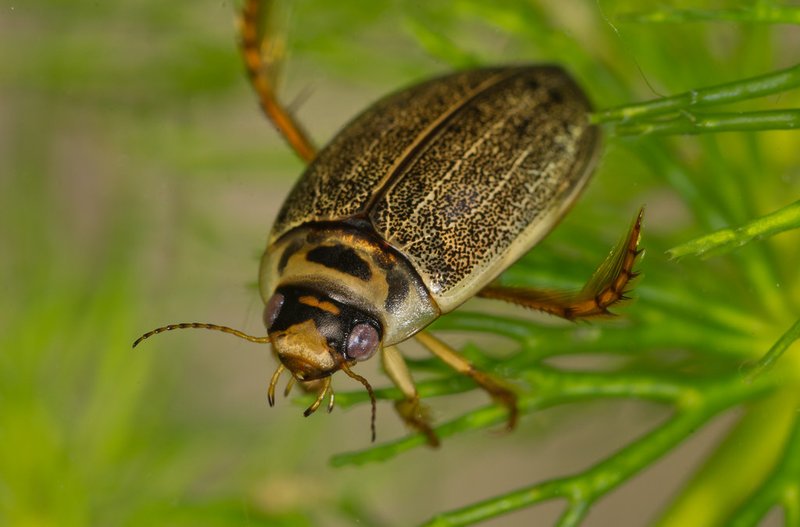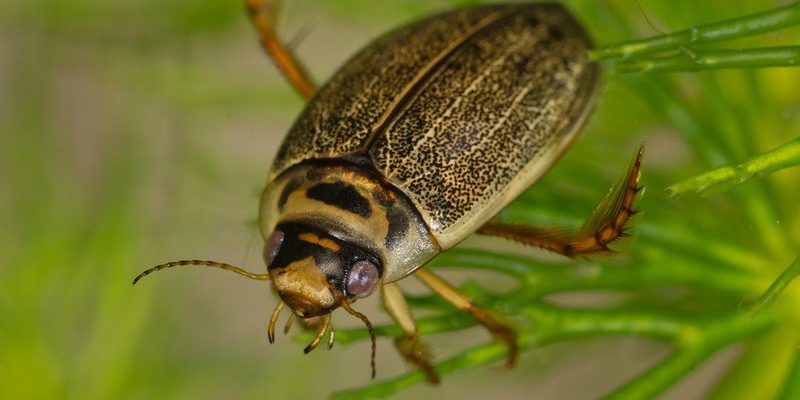
Diving beetles are like the superheroes of the insect world. Picture them as tiny swimmers, gliding effortlessly through water with sleek bodies and powerful legs. They belong to a family of insects called Dytiscidae, known for their impressive diving skills. These remarkable creatures can be found in many freshwater habitats, from ponds to lakes, and while their presence might go unnoticed, their role in the ecosystem is vital.
Now, you might be wondering what makes these beetles so fascinating. Well, diving beetles are not only great swimmers; they’re also exceptional hunters. Equipped with strong mandibles, they capture prey with impressive speed. If you’ve ever seen them darting around in the water, you’ll understand why they are often compared to underwater torpedoes. Let’s dive deeper into the world of diving beetles and explore their unique characteristics, behaviors, and habitats.
Physical Characteristics
Diving beetles come in various sizes, but they typically range from about 0.5 to 2 inches long. Their bodies are streamlined, allowing them to slice through water effortlessly. Most diving beetles have a dark, shiny exterior, often appearing in shades of black or dark brown, which helps them blend into their underwater environment. This coloration serves as excellent camouflage, protecting them from predators.
One of the most striking features of diving beetles is their long, hairy legs. These legs act like paddles, propelling them swiftly through the water. You might notice that their front legs are more robust than the back ones, which is an adaptation that helps them grab onto their prey. The diving beetle’s elytra, or wing covers, are also designed to trap air, allowing them to breathe while submerged.
From their unique body shape to their specialized appendages, each aspect of a diving beetle is purposefully designed for an aquatic life. Their physical adaptations not only enhance their swimming abilities but also play a crucial role in their survival in various freshwater ecosystems.
Habitat and Distribution
Diving beetles thrive in a range of freshwater habitats including ponds, lakes, marshes, and slow-moving rivers. They prefer environments with plenty of vegetation, as this offers both food and shelter. The presence of aquatic plants provides hiding spots for them to ambush their prey while also offering a safe place for their eggs. You can often find them lurking among lily pads or submerged branches.
These beetles are distributed worldwide, with over 4,000 species identified. Whether you live in North America, Europe, or Asia, there’s likely a diving beetle in your local waterways. The diversity of species means you might encounter variations in size, color, and behavior, from the tiny Hydroporus to the larger Dytiscus.
What’s fascinating is that diving beetles can adapt to various environmental conditions. However, they do require clean water to thrive, making them important indicators of environmental health. If the water quality declines, diving beetles often become scarce, signaling a potential ecological imbalance.
Diet and Feeding Behavior
Diving beetles are carnivorous, primarily feeding on other aquatic organisms. Their diet mainly consists of insects, tadpoles, and small fish. Imagine them as nature’s little hunters—silently gliding through the water, their acute sense of smell leading them to their next meal. Once they spot their prey, diving beetles use their strong jaws to catch and consume it quickly.
Interestingly, these beetles have a unique method of feeding. They often capture their prey and hold it underwater, using a combination of their speed and powerful mandibles. Some species even have specialized adaptations to help them suck the juices out of their prey, much like a vampire of the aquatic world! This feeding behavior not only helps them survive but also plays a crucial role in controlling insect populations in their habitat.
It’s a bit like a well-timed ballet performance underwater—graceful yet fierce. Diving beetles are efficient predators, ensuring that their ecosystems remain balanced and healthy. Their predatory habits can actually help maintain fish populations and keep aquatic landscapes thriving.
Life Cycle and Reproduction
The life cycle of a diving beetle is a fascinating journey that begins with eggs. Female diving beetles lay their eggs on the surface of aquatic plants or submerged debris. When the eggs hatch, the larvae emerge and are quite different from the adults. These larvae resemble small, elongated versions of the adults but possess a more streamlined form, gearing them for a predatory lifestyle.
Larval diving beetles are voracious hunters, even more aggressive than their adult counterparts. They have a unique way of capturing prey, often using a retractable jaw to snag unsuspecting victims. This stage of their life cycle typically lasts several weeks to months, depending on the species and environmental conditions.
After going through a series of molts, the larvae eventually pupate, transforming into adults. This metamorphosis can be a bit of a waiting game, as they need to develop and mature before taking on their final form. Once the transformation is complete, they return to the water, ready to continue the cycle of life as adult diving beetles.
Behavior and Adaptations
Diving beetles are well-known for their impressive swimming abilities, but their behavior is equally fascinating. When under the water, they can hold air bubbles beneath their elytra, which allows them to breathe and stay submerged for extended periods. This is akin to carrying a tiny scuba tank with them wherever they go!
These beetles are also nocturnal, often hunting at night when there is less activity in the water. This behavior not only helps them avoid predators but also gives them the advantage of surprising their prey. If you’ve ever been by a pond at dusk, you might have noticed them darting about, their movements quick and purposeful.
Another interesting fact about diving beetles is their ability to adjust to changing environments. They can survive in varying water conditions, adapting their behavior and diet according to the availability of food. This resilience makes them a crucial part of the ecosystems they inhabit, as they help control populations and maintain balance even in less-than-ideal conditions.
Conservation Status
While many diving beetle species are abundant and widespread, some are facing threats due to habitat loss and pollution. Wetland drainage, agricultural runoff, and urban development can significantly impact their populations. These changes not only eliminate essential breeding grounds but also introduce harmful chemicals into their habitats.
Conservation efforts are crucial for the survival of these remarkable insects. Protecting freshwater habitats and promoting clean water initiatives can help maintain healthy environments for diving beetles. Organizations and researchers are continually working to monitor populations and raise awareness about the importance of these creatures in aquatic ecosystems.
If we can create awareness and build conservation strategies, we can ensure that future generations get to witness the beauty and ecological significance of diving beetles. After all, preserving biodiversity is not just about saving one species; it’s about maintaining the delicate balance of our planet’s ecosystems.
Interesting Facts About Diving Beetles
| Size: | 0.5 to 2 inches |
| Habitat: | Ponds, lakes, marshes |
| Diet: | Carnivorous – insects, tadpoles, small fish |
| Lifespan: | 1 to 3 years |
| Coloration: | Dark brown to black |
| Active Time: | Nocturnal |
FAQ
Are diving beetles dangerous to humans?
Diving beetles are not dangerous to humans. Their strong mandibles are adapted for catching small prey, and they don’t pose a threat to us. If provoked, they might bite, but it’s not harmful. They’re far more interested in their aquatic diet than interacting with us.
How can I identify a diving beetle?
You can identify a diving beetle by looking for its streamlined body and elongated shape. They often have shiny, dark-colored shells and distinctive long legs that are adapted for swimming. If you spot them darting around in the water, you’re likely observing a diving beetle in action!
Can diving beetles breathe underwater?
Yes, diving beetles can breathe underwater! They trap air bubbles beneath their elytra, which allows them to access oxygen while submerged. This clever adaptation lets them dive for long periods without needing to surface for air.
What is the role of diving beetles in the ecosystem?
Diving beetles play a crucial role in their ecosystems. As predators, they help control populations of other aquatic organisms, such as insects and tadpoles. This balancing act ensures a healthy aquatic environment, making them essential for maintaining biodiversity in freshwater habitats.
How long do diving beetles live?
Diving beetles generally live for about 1 to 3 years. Their lifespan can vary based on species, environmental conditions, and availability of food. Under ideal circumstances, they can thrive and reproduce multiple times within their life cycle.
Where can I find diving beetles?
You can find diving beetles in a variety of freshwater habitats, including ponds, lakes, and marshes. They tend to prefer areas with plenty of vegetation, which provides both food and shelter. If you’re near a body of water, take a closer look—you might just spot some swimming around!
Are diving beetles good for gardens?
Yes, diving beetles can be beneficial for gardens, especially if you have a pond or water feature. They help control pest populations by preying on insects that may damage plants. Their presence indicates a healthy ecosystem, making them a plus for your garden’s biodiversity.
Do diving beetles have any natural predators?
Yes, diving beetles face threats from various predators, including fish, birds, and other larger insects. Their dark coloration helps them blend into their environment, reducing the chances of being spotted. However, they must always be cautious while navigating their aquatic habitats.
Can I keep diving beetles as pets?
While it is possible to keep diving beetles as pets, it requires a proper setup to mimic their natural habitat. A small aquarium with clean water and plants can work, but it’s important to keep their needs in mind and ensure they have plenty of space to swim and hunt.
What do I do if I find a diving beetle?
If you find a diving beetle, the best approach is to observe it from a distance. If it’s out of water, gently place it back into a nearby pond or stream. Make sure the environment is safe for it, and avoid handling them too much to prevent stress.
How do diving beetles help with water quality?
Diving beetles are important indicators of water quality. Their presence usually signifies a healthy aquatic ecosystem. By preying on other insects and controlling their populations, they contribute to maintaining balance and ensuring that water bodies remain vibrant and clean.

